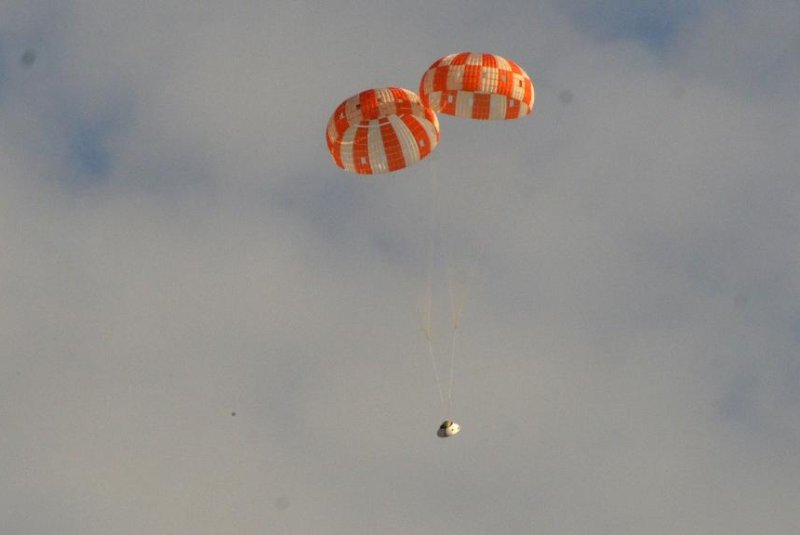During a rent test of Orion's breaking system, an Orion model slowed to a safe landing speed after only two of its three main parachutes deployed. Photo by NASA
YUMA, Ariz., Aug. 26 (UPI) -- The Orion space capsule's parachute system passed its latest test on Wednesday, in which engineers simulated a mechanical failure.
Similar to previous tests, the Orion prototype was dropped from the upper reaches of the atmosphere -- by a C-17 aircraft instead of a balloon -- and allowed to free fall toward Earth's surface. Only this time, the craft's parachutes were programmed by NASA engineers to only partially deploy.
Orion's braking system boasts two sets of parachutes. The initial two "drogue" parachutes are deployed at high altitude to stabilize the craft upon re-entry. A few second later in the approach, three main parachutes are inflated to slow the capsule to a safe landing speed.
During the most recent test, one of the two drogue parachutes was engineered to fail, as well one of the three main chutes. Orion's parachute system passed the test, landing safely on the desert soil of the U.S. Army Yuma Proving Ground in Yuma, Ariz., after 6.5-mile trip through the atmosphere.
"We test Orion's parachutes to the extremes to ensure we have a safe system for bringing crews back to Earth on future flights, even if something goes wrong," C.J. Johnson, project manager for Orion's parachute system, said in a press release. "Orion's parachute performance is difficult to model with computers, so putting them to the test in the air helps us better evaluate and predict how the system works."
The test didn't feature the Orion capsule itself, but a model with the crew-carrying spacecraft's dimensions, weight and aerodynamics.
The real Orion craft and its now tried-and-tested parachute system will be reunited for a series of tests early next year. Beginning in 2016, the craft will undergo eight airdrops over a three-year period. If it passes those tests, it will be qualified for crewed flights.
NASA's Orion Multi-Purpose Crew Vehicle, called Orion or Orion MPCV, for short, is being designed with long-distance space travel in mind. Though the four-man capsule may initially ferry astronauts to and from the space station, NASA hopes the craft will eventually spearhead missions to explore asteroids and, ultimately, Mars.















